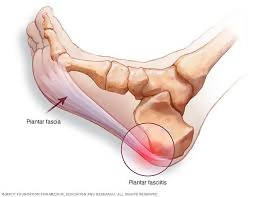You might feel stiffness and pain in your heel when you wake up in the morning or while lying down on the bed. This pain could be due to conditions like plantar fasciitis or an injury such as a stress fracture.
Plantar fasciitis is one of the most common causes of chronic pain below the heel of the foot. According to a recent study conducted by the American Academy of Orthopedic Surgeons, there are about two million cases of Plantar Fasciitis treated each year.
One in ten people is prone to develop this condition at a certain point in their lives. Plantar Fasciitis counts for around 11 to 15 per cent of foot symptoms that require cure or treatment, as per a review of researches related to this condition.
The Symptoms of Plantar Fasciitis
Plantar Fasciitis is a condition that is marked by acute and piercing heel pain. It generally occurs when you wake up in the morning or stand up after sitting for a long time. The most frequent symptoms of this condition are- stabbing pain, a state which can also result in swelling of the heel area.
The pain from this condition can be quite severe after rest and gradually assuages during the day. However, you should avoid exercising and standing on your foot for a long period as the pain may reappear by doing so.
The plantar fascia is a thick band of the ligament or connective tissue positioned below the foot. This band of the ligament which helps to support the curve of the foot works like a bowstring of the bow and is meant to endure any pressure or strain experienced by the feet.
A person may develop inflammation or stress of the fascia over the years and it eventually becomes a persistent or chronic condition. A person suffering from plantar fasciitis never really take sufficient to recover or get better.
The Causes of Plantar Fasciitis
A person suffers from plantar fasciitis when the plantar fascia turns stiff due to extreme strain and pressure that results in inflammation. The more tension the plantar fascia experiences, the greater vexation, and inflammation will be there. Therefore, any increase in stress and tearing causes the condition and gives rise to pain in the heel.
Plantar fasciitis is more frequently seen in active men and women aged between 40 and 70 years. Women are more prone to develop this condition as compared to men. A retrospective study about running injuries conducted in 2002 indicated that 7.8 per cent of the injuries suffered by athletes, specifically runners were plantar fasciitis. This condition was listed among one of the 5 most recurrent running injuries.

The Risk Factors for Plantar Fasciitis
In most cases, plantar fasciitis develops for no clear and identifiable cause. Several risk factors can give rise to plantar fasciitis such as:
- Increased pressure on the heels-
This condition is most common in people who walk or run frequently and stand on their feet for a longer time. Various occupations such as a factory worker or teacher require long hours of walking or standing and people associated with such professions are more prone to develop this condition.
Excessive weight gain can result in the damage of plantar fascia which makes it unable to endure any shock and leads to pain in the heel. About 70 per cent of people suffering from plantar fasciitis are obese. A recent study also reports that there is a direct relationship between higher body mass index (BMI) and non-athletes suffering from this condition. Pregnancy is also a common reason for developing plantar fasciitis.
3) Foot Abnormalities
People who have foot abnormalities like flat feet have increased chances of developing this condition as the entire soles of their feet are in contact with the ground while standing. Likewise, clavus foot also increases your risk of suffering from plantar fasciitis because a greater amount of strain is experienced by your heel and ball of the foot when you stand or walk.
Other causes of plantar fasciitis include- Wearing the wrong shoes, inflammatory diseases, diabetes, Bursitis, and arthritis.
Diagnosis of Plantar Fasciitis
Severe pain in the heel is the main symptom of this condition. If you don’t get relief from the pain after several weeks, then you should consult a podiatrist near Houston.
A podiatrist in Houston at DeNiel Foot and Ankle Center will conduct an X-ray to examine your foot and identify the condition that is causing the pain.
Heel spurs are small and sharp outgrowths located on the calcaneus bone. They can often be seen on the X-rays. However, heel spurs are not believed to be the reason for the pain in plantar fasciitis.
According to Houston podiatrists, one out of ten people have the heel spurs. However, just one out of twenty people with heel spurs suffer from plantar fasciitis.

If you will not seek any treatment for plantar fasciitis, then it can result in impaired mobility, back and hip problems, and other foot conditions.
If you have any queries, please feel free to contact our office located in Houston, TX. We offer the newest diagnostic and treatment technologies for all your foot and ankle needs.